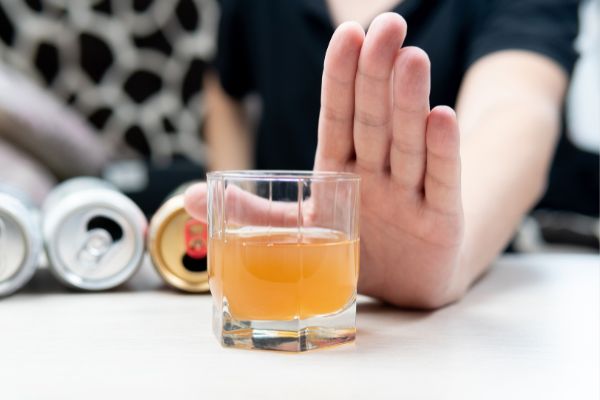How to diagnose large intestinal fluke in Vietnam? Can the patient use alcohol during the course of taking specific drugs to treat the disease?
Diagnosing large intestinal fluke disease by what methods?
Pursuant to Section 3, Section 4 of the Guidelines issued together with Decision 1636/QD-BYT in 2022, there are guidelines on testing and diagnosis of large intestinal fluke in Vietnam disease as follows:
“3. SUBCLINICAL
3.1. Blood tests
- Blood count test: red blood cell count decreased, hemoglobin decreased; Eosinophilia can increase by 15 - 20%.
- Blood biochemistry: can decrease blood albumin in severe form.
3.2. Image analysation
- Chest X-ray: can see pericardial effusion, pleural effusion;
- Unprepared abdominal X-ray: can show bowel obstruction, peritoneal effusion;
- Ultrasound: pleural ultrasound, pericardial ultrasound, abdominal ultrasound can see effusion images depending on the degree. Abdominal ultrasound can show inflammatory bowel disease, intestinal obstruction.
3.3. Test stool, duodenal fluid, specimen
- Fecal examination for large intestinal fluke eggs by Kato - Katz technique, or Ether - Formalin technique, sedimentation technique: find large intestinal fluke eggs.
- Endoscopy of duodenum by fresh endoscopic technique: identify eggs of fluke.
- Gastrointestinal endoscopy: can see adult intestinal fluke.
- Making specimens of large intestinal fluke by Carmin method: identify flukes.
3.4. Molecular biology test
PCR test for species identification: distinguishing between large intestinal flukes and large liver flukes.
4. DIAGNOSIS
4.1. Suspected case
If you have the following symptoms:
- Fatigue, loss of appetite, weight loss;
- Abdominal pain, diarrhea, abdominal distension;
- Or symptoms of anemia;
- There is an epidemiological history of eating aquatic vegetables or a family living in an area endemic for large intestinal flukes.
4.2. Identified case
Is a suspected case and one of the following criteria is added:
- Fecal examination identified large intestinal fluke eggs.
- PCR test identified large intestinal fluke species.
A complete blood count may show an eosinophil increase of 15-20%.
4.3. Differential diagnosis
- Large liver fluke: based on the egg image, the egg density in the feces of the liver fluke is less. Large liver fluke causes damage to liver parenchyma, biliary tract, ELISA detects antibodies of liver fluke positive. PCR for species identification to differentiate between large intestinal flukes and large liver flukes.
- Intestinal strongyloides: fresh fecal smear test finds strongyloidiasis larvae in stool or ELISA detects strong strongyloidiasis antibodies.
- Large intestinal fluke eggs can be confused with unfertilized roundworm eggs.
Accordingly, the paraclinical method will be performed through blood tests, imaging tests, stool tests, duodenal fluid, and specimens according to the above regulations.
The diagnostic case will include the diagnosis of the suspected disease, the confirmed case, and the differential diagnosis.

How to diagnose large intestinal fluke in Vietnam? Can the patient use alcohol during the course of taking specific drugs to treat the disease? (Image from the internet)
Should not use alcohol while taking medicine to treat large intestinal fluke?
Pursuant to Section 5 of the Guidelines issued together with Decision 1636/QD-BYT in 2022, there are guidelines on the treatment of large intestinal fluke in Vietnam disease as follows:
“5. TREATMENT
5.1. The principles of treatment
- Early treatment, right specific drugs, right regimen;
- Supportive treatment when necessary to improve the patient's condition;
- The patient re-examined after 1 month of treatment to evaluate the effectiveness of treatment; if the patient is still infected with large intestinal flukes, continue treatment and repeat the course of treatment;
- Patients with comorbidities must be combined with treatment monitoring.
5.2. Specific treatment
a) Medicine: praziquantel 600 mg tablets.
- Dosage:
+ For adults and children ≥ 4 years old: Dose 25 mg/kg/day, single dose, taken immediately after eating, do not chew the medicine.
+ For children < 4 years old: Consult a doctor during treatment and closely monitor.
- Contraindications:
+ Not for use by pregnant women;
+ People who are allergic to the drug;
+ People who are suffering from acute illness or heart failure, liver failure, kidney failure, mental illness...
- Instruct the patient to pay attention when using the drug:
+ Lactation period: The mother stops breastfeeding during the period of taking the drug and 72 hours after the last dose; During this time the milk must be expressed;
+ Do not use alcohol during the treatment period;
+ Do not drive, operate machinery while taking the drug and also for 24 hours after taking praziquantel because the drug can cause dizziness and drowsiness;
+ Be careful with the elderly, malnourished people, people with vestibular disorders.
5.3. Symptomatic treatment
Depending on the clinical symptoms to prescribe appropriate drugs.
- Relieve abdominal pain: by oral antispasmodics.
- Diarrhea and digestive disorders: digestive enzymes of bacterial origin.
- Oral rehydration, electrolytes: Oresol.
- Edema: due to hypoalbuminemia, albumin should be infused.
- Anemia: supplement with folic acid, iron tablets, vitamin B12 in case of mild anemia, take within 3-6 months.
- Acute intestinal obstruction: combined with surgical intervention to treat intestinal obstruction first, then combined with specific drug treatment for large intestinal flukes.
5.4. Supportive treatment
- Improve physical condition with proper diet and rest.
- Use multivitamins.
5.5. Follow-up after treatment
5.5.1. Inpatient follow-up
Patients are monitored for inpatient treatment for about 5-7 days, and can do tests to diagnose, monitor treatment, evaluate organ functions of the body; for patients with underlying disease, do tests to monitor and treat related underlying diseases.
5.5.2. Monitoring of outpatient treatment and after inpatient treatment
- Re-examination after 1 week: the patient is re-evaluated blood count, liver and kidney function; stool examination for large intestinal fluke eggs.
- Re-examination after 1 month: the patient is re-evaluated blood count, liver and kidney function; stool examination for large intestinal fluke eggs.
- After 1 week or 1 month, if the patient's stool test still has large intestinal fluke eggs or adult flukes, the patient should be admitted to the hospital and repeat the inpatient treatment course."
Thus, the treatment of intestinal fluke disease is carried out according to the above instructions. In case of using specific drugs to treat large intestinal fluke disease, the patient must not use alcohol during the treatment period.
How to prevent large intestinal fluke disease effectively?
Pursuant to Section 7 of the Guidelines issued together with Decision 1636/QD-BYT in 2022, there are guidelines on the prevention of large intestinal fluke in Vietnam disease as follows:
“7. PREVENTION
- Propagating and educating about the causes, harms, transmission routes and prevention methods of large intestinal fluke disease.
- Eat and drink cooked food, do not use fresh manure to fertilize fields, and do not defecate indiscriminately into water sources.
- Do not eat live or undercooked aquatic plants, detect and treat sick people.
Thus, in order to effectively prevent large intestinal fluke in Vietnam disease, we should eat cooked, drink cooked, do not use fertilizer to fertilize the fields, do not defecate into water sources and do not eat live or undercooked aquatic animals. ripe.
LawNet
